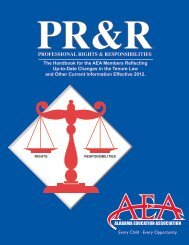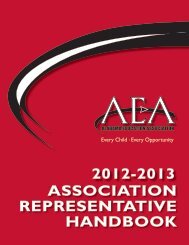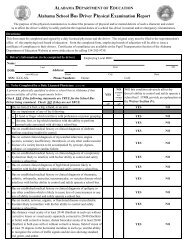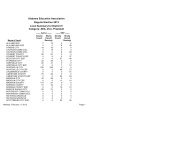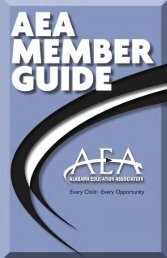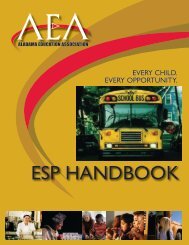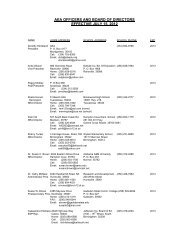A Teacher's Guide to Religion - Alabama Education Association
A Teacher's Guide to Religion - Alabama Education Association
A Teacher's Guide to Religion - Alabama Education Association
- No tags were found...
Create successful ePaper yourself
Turn your PDF publications into a flip-book with our unique Google optimized e-Paper software.
A Teacher’s <strong>Guide</strong> <strong>to</strong><strong>Religion</strong>in the Public SchoolsfirstamendmentA SPECIAL EDITION PUBLISHED BY THE ALABAMA EDUCATION ASSOCIATIONIN COLLABORATION WITH THE FIRST AMENDMENT CENTER.
A Teacher’s <strong>Guide</strong> <strong>to</strong> <strong>Religion</strong> in the Public Schoolsis published by the First Amendment Center.The guide has been endorsed by the following organizations:American <strong>Association</strong> of School Administra<strong>to</strong>rsAmerican Federation of TeachersAmerican Jewish CommitteeAmerican Jewish Congress<strong>Association</strong> for Supervision and Curriculum DevelopmentBaptist Joint Committee on Public AffairsChristian Educa<strong>to</strong>rs <strong>Association</strong> InternationalChristian Legal SocietyCouncil on Islamic <strong>Education</strong>National <strong>Association</strong> of Elementary School PrincipalsNational <strong>Association</strong> of EvangelicalsNational <strong>Association</strong> of Secondary School PrincipalsNational Council of Churches of Christ in the U.S.A.National Council for the Social StudiesNational <strong>Education</strong> <strong>Association</strong>National PTANational School Boards <strong>Association</strong>Union of American Hebrew CongregationsUnion of Orthodox Jewish Congregations of America©1999 First Amendment Center1207 18th Avenue SouthNashville, TN 37212615/727-1600www.firstamendmentcenter.orgReprinted with permission by the <strong>Alabama</strong> <strong>Education</strong> <strong>Association</strong>.Written by Charles C. HaynesDesign: Sonya WatsonEdi<strong>to</strong>r: Natilee Duning
A Teacher’s <strong>Guide</strong> <strong>to</strong> <strong>Religion</strong>in the Public Schools“Congress shall make no law respecting an establishmen<strong>to</strong>f religion, or prohibiting the free exercise thereof; orabridging the freedom of speech, or of the press;or the right of the people peaceably <strong>to</strong> assemble,and <strong>to</strong> petition the government for a redress of grievances.”– FIRST AMENDMENT TO THE U.S. CONSTITUTIONEach day millions of parents from diverse religious backgroundsentrust the education of their children <strong>to</strong> the teachers in our nation’spublic schools. For this reason, teachers need <strong>to</strong> be fully informed aboutthe constitutional and educational principles for understanding the role ofreligion in public education.This teacher’s guide is intended <strong>to</strong> move beyond the confusion andconflict that has surrounded religion in public schools since the early daysof the common school movement. For most of our his<strong>to</strong>ry, extremes haveshaped much of the debate. On one end of the spectrum are those whoadvocate promotion of religion (usually their own) in school practicesand policies. On the other end are those who view public schools as religion-freezones. Neither of these approaches is consistent with the guidin gprinciples of the <strong>Religion</strong> Clauses of the First Amendment.Fortunately, however, there is another alternative that is consistentwith the First Amendment and broadly supported by many educationaland religious groups. The core of this alternative has been bestarticulated in “Religious Liberty, Public <strong>Education</strong>, and the Future ofAmerican Democracy,” a statement of principles issued by 24 nationalorganizations. Principle IV states:1
Public schools may not inculcate nor inhibitreligion. They must be places where religion andreligious conviction are treated with fairness andrespect. Public schools uphold the First Amendmentwhen they protect the religious liberty rights of studentsof all faiths or none. Schools demonstrate fairness whenthey ensure that the curriculum includes study aboutreligion, where appropriate, as an important part of acomplete education. 1The questions and answers that follow build on this shared vision ofreligious liberty in public education <strong>to</strong> provide teachers with a basicunderstanding of the issues concerning religion in their classrooms. Theadvice offered is based on First Amendment principles as currentlyinterpreted by the courts and agreed <strong>to</strong> by a wide range of religious andeducational organizations. For a more in-depth examination of the issues,teachers should consult Finding Common Ground: A <strong>Guide</strong> <strong>to</strong> ReligiousLiberty in Public Schools. ii This guide is not intended <strong>to</strong> render legaladvice on specific legal questions; it is designed <strong>to</strong> provide generalinformation on the subject of religion and public schools.Keep in mind, however, that the law alone cannot answer everyquestion. Teachers and administra<strong>to</strong>rs, working with parents and others inthe community, must work <strong>to</strong> apply the First Amendment fairly andjustly for all students in our public schools.2
Teaching about <strong>Religion</strong> in Public Schools1.Is it constitutional <strong>to</strong> teach about religion?Yes. In the 1960s’ school prayer cases (that prompted rulings againststate-sponsored school prayer and Bible reading), the U.S. SupremeCourt indicated that public school education may includeteaching about religion. In Abing<strong>to</strong>n v. Schempp, Associate Justice TomClark wrote for the Court:2.[I]t might well be said that one’s education is notcomplete without a study of comparative religion orthe his<strong>to</strong>ry of religion and its relationship <strong>to</strong> theadvancement of civilization. It certainly may be saidthat the Bible is worthy of study for its literary andhis<strong>to</strong>ric qualities. Nothing we have said here indicatesthat such study of the Bible or of religion, whenpresented objectively as part of a secular program ofeducation, may not be effected consistently with theFirst Amendment.Why should study about religion be included in thecurriculum?Growing numbers of educa<strong>to</strong>rs throughout the United Statesrecognize that study about religion in social studies, literature, art, andmusic is an important part of a well-rounded education. “<strong>Religion</strong> in thePublic School Curriculum: Questions and Answers,” issued by acoalition of 17 major religious and educational organizations —including the Christian Legal Society, the American Jewish Congress, theNational <strong>Education</strong> <strong>Association</strong>, the American Federation of Teachers,the American <strong>Association</strong> of School Administra<strong>to</strong>rs, the Islamic Societyof North America, the National Council for the Social Studies, the<strong>Association</strong> for Supervision and Curriculum Development, the BaptistJoint Committee on Public Affairs, the National <strong>Association</strong> ofEvangelicals, and the National School Boards <strong>Association</strong> — describesthe importance of religion in the curriculum thus:3
3.Is study about religion included in textbooks andstandards?“Knowledge about religions is not only characteristic of an educatedperson, but is also absolutely necessary for understanding and living ina world of diversity.” iNational Council for the Social StudiesAgreement on the importance of teaching about religion has begun <strong>to</strong>influence the treatment of religion in textbooks widely used in publicschools, as well as state frameworks and standards for the social studies.The current generation of his<strong>to</strong>ry textbooks mention religion more oftenthan their predecessors, and, in world his<strong>to</strong>ry, sometimes offer substantivediscussions of religious ideas and events.State frameworks and standards are also beginning <strong>to</strong> treat religionmore seriously. Most state standards in the social studies require orrecommend teaching about religion through specific content referencesand general mandates, and many also include such references in fine artsand literature standards. In California, for example, the His<strong>to</strong>ry-SocialScience Framework and the new His<strong>to</strong>ry-Social Science ContentStandards require considerable study of religion. Students studying U.S.His<strong>to</strong>ry in California are expected <strong>to</strong> learn about the role of religion in theAmerican s<strong>to</strong>ry, from the influence of religious groups on social reformmovements <strong>to</strong> the religious revivals, from the rise of Christianfundamentalism <strong>to</strong> the expanding religious pluralism of the 20th century.Teaching about religion is also encouraged in the National Standardsfor His<strong>to</strong>ry, published by the National Center for His<strong>to</strong>ry in the Schools.The elaborated standards in world his<strong>to</strong>ry are particularly rich in religiousreferences, examining the basic beliefs and practices of the majorreligions as well as how these faiths influenced the development ofcivilization in successive his<strong>to</strong>rical periods. While the U.S. his<strong>to</strong>rystandards include religion less frequently, many his<strong>to</strong>rical developmentsand contributions that were influenced by religion are neverthelessrepresented.5
Geography for Life: The National Geography Standards, publishedby the Geography Standards Project, and the National Standards forCivics and Government, published by the Center for Civic <strong>Education</strong>,include many references <strong>to</strong> teaching about religious belief and practice ashis<strong>to</strong>rical and contemporary phenomena. Study of religion in the socialstudies would be expanded considerably if curriculum developers andtextbooks writers were guided by these standards.4.How should I teach about religion?Encouraged by the new consensus, public schools are now beginning<strong>to</strong> include more teaching about religion in the curriculum. In the socialstudies especially, the question is no longer “Should I teach about religion?”but rather “How should I do it?”The answer <strong>to</strong> the “how” question begins with a clear understandingof the crucial difference between the teaching of religion (religiouseducation or indoctrination) and teaching about religion. “<strong>Religion</strong> in thePublic School Curriculum,” the guidelines issued by 17 religious andeducational organizations, summarizes the distinction this way:• The school’s approach <strong>to</strong> religion is academic not devotional.• The school strives for student awareness of religions, but does notpress for student acceptance of any religion.• The school sponsors study about religion, not the practice ofreligion.• The school may expose students <strong>to</strong> a diversity of religious views, butmay not impose any particular view.• The school educates about all religions; it does not promote ordenigrate religion.• The school informs students about various beliefs; it does not seek<strong>to</strong> conform students <strong>to</strong> any particular belief. iiClassroom discussions concerning religion must be conducted in anenvironment that is free of advocacy on the part of the teacher. Studentsmay, of course, express their own religious views, as long as suchexpression is germane <strong>to</strong> the discussion. But public school teachers are6
equired by the First Amendment <strong>to</strong> teach about religion fairly andobjectively, neither promoting nor denigrating religion in general orspecific religious groups in particular. When discussing religion, manyteachers guard against injecting personal religious beliefs by teachingthrough attribution (e.g. by using such phrases as “most Buddhistsbelieve . . .” or “according <strong>to</strong> the Hebrew scriputres . . .”).5.Which religions should be taught and how muchshould be said?Decisions about which religions <strong>to</strong> include and how much <strong>to</strong> discussabout religion are determined by the grade level of the students and theacademic requirements of the course being taught.In the elementary grades, the study of family, community, variouscultures, the nation, and other themes and <strong>to</strong>pics may involve somediscussion of religion. Elementary students are introduced <strong>to</strong> the basicideas and practices of the world’s major religions by focusing on thegenerally agreed upon meanings of religious faiths — the core beliefs andsymbols as well as important figures and events. S<strong>to</strong>ries drawn fromvarious faiths may be included among the wide variety of s<strong>to</strong>ries read bystudents, but the material selected must always be presented in thecontext of learning about religion.On the secondary level, the social studies, literature, and the arts offeropportunities for the inclusion of study about religions — their ideas andpractices. The academic needs of the course determine which religionsare studied. In a U.S. his<strong>to</strong>ry curriculum, for example, some faithcommunities may be given more time than others but only because oftheir predominant influence on the development of the American nation.In world his<strong>to</strong>ry, a variety of faiths are studied in each region of the worldin order <strong>to</strong> understand the various civilizations and cultures that haveshaped his<strong>to</strong>ry and society. The overall curriculum should include all ofthe major voices and some of the minor ones in an effort <strong>to</strong> provide thebest possible education.7
Fair and balanced study about religion on the secondary levelincludescritical thinking about his<strong>to</strong>rical events involving religious traditions.Religious beliefs have been at the heart of some of the best and some ofthe worst developments in human his<strong>to</strong>ry. The full his<strong>to</strong>rical record (andvarious interpretations of it) should be available for analysis anddiscussion. Using primary sources whenever possible allows students <strong>to</strong>work directly with the his<strong>to</strong>rical record.Of course, fairness and balance in U.S. or world his<strong>to</strong>ry and literatureare difficult <strong>to</strong> achieve, given the brief treatment of religious ideas andevents in most textbooks and the limited time available in the coursesyllabus. Teachers will need scholarly supplemental resources that enablethem <strong>to</strong> cover the required material within the allotted time, whilesimultaneously enriching the discussion with study of religion. Someschools now offer electives in religious studies in order <strong>to</strong> provideadditional opportunities for students <strong>to</strong> study about the major faithcommunities in greater depth.6.May I invite guest speakers <strong>to</strong> help with study aboutreligion?When teaching about religions in his<strong>to</strong>ry, some teachers may find ithelpful <strong>to</strong> invite a guest speaker for a more comprehensive presentationof the religious tradition under study. Teachers should consult their schooldistrict policy concerning guest speakers in the classroom.If a guest speaker is invited, care should be taken <strong>to</strong> find someonewith the academic background necessary for an objective and scholarlydiscussion of the his<strong>to</strong>rical period and the religion being considered.Faculty from local colleges and universities often make excellent guestspeakers or can make recommendations of others who might beappropriate for working with students in a public school setting.Religious leaders in the community may also be a resource. Remember,however, that they have commitments <strong>to</strong> their own faith. Be certain thatany guest speaker understands the First Amendment guidelines forteaching about religion in public education and is clear about theacademic nature of the assignment.8
7.How should I treat religious holidays in the classroom?Teachers must be alert <strong>to</strong> the distinction between teaching aboutreligious holidays, which is permissible, and celebrating religiousholidays, which is not. Recognition of and information about holidaysmay focus on how and when they are celebrated, their origins, his<strong>to</strong>ries,and generally agreed upon meanings. If the approach is objective andsensitive, neither promoting nor inhibiting religion, this study can fosterunderstanding and mutual respect for differences in belief. Teachers maynot use the study of religious holidays as an opportunity <strong>to</strong> proselytize orotherwise inject personal religious beliefs in<strong>to</strong> the discussion.The use of religious symbols, provided they are used only asexamples of cultural or religious heritage, is permissible as a teaching aidor resource. Religious symbols may be displayed only on a temporarybasis as part of the academic lesson being studied. Students may choose<strong>to</strong> create artwork with religious symbols, but teachers should not assignor suggest such creations.The use of art, drama, music or literature with religious themes ispermissible if it serves a sound educational goal in the curriculum. Suchthemes should be included on the basis of their academic or aestheticvalue, not as a vehicle for promoting religious belief. For example, sacredmusic may be sung or played as part of the academic study of music.School concerts that present a variety of selections may include religiousmusic. Concerts should avoid programs dominated by religious music,especially when these coincide with a particular religious holiday.This advice about religious holidays in public schools is based onconsensus guidelines adopted by 18 educational and religiousorganizations. iv8.Are there opportunities for teacher education in studyabout religion?Teacher preparation and good academic resources are needed in orderfor study about religion in public schools <strong>to</strong> be constitutionallypermissible and educationally sound.9
The First Amendment Center supports initiatives in several regions of thecountry designed <strong>to</strong> prepare public school teachers <strong>to</strong> teach about religion. Themost extensive of these programs is the California 3Rs Project (Rights,Responsibilities, and Respect). Co-sponsored by the California CountySuperintendents <strong>Education</strong>al Services <strong>Association</strong>, the project has created anetwork of resource leaders and scholars throughout the state providing supportfor classroom teachers. Teachers trained by the project give workshops for theircolleagues on the constitutional and educational guidelines for teaching aboutreligion. Religious studies scholars from local colleges and universities arelinked with school districts <strong>to</strong> provide ongoing expertise and periodic seminarson the religious traditions that teachers are discussing in the curriculum.The Utah State Office of <strong>Education</strong> co-sponsors a Utah 3Rs Project that iscurrently building a network of resource leaders in all of the state’s schooldistricts. Other states and districts have similar programs in various stages ofdevelopment. v Harvard University and the University of Pennsylvania offermaster’s level programs that are excellent opportunities for both current andprospective public and private school teachers interested in learning more aboutthe study of religion and religious-liberty issues in American publiclife. vi Other colleges and universities offer assistance <strong>to</strong> teachers, includingin-service programs focused on teaching about religion. A notable example isthe <strong>Religion</strong> and Public <strong>Education</strong> Resource Center at California StateUniversity – Chico. This center provides resources, including curriculum guidesand sample lessons in several subject areas. vii Other organizations, such as theCouncil on Islamic <strong>Education</strong>, offer academic resources and workshops onteaching about specific religious traditions. viii9.What are good classroom resources for teaching aboutreligion?Teaching about religion in the public schools requires that soundacademic resources be made readily available <strong>to</strong> classroom teachers.Fortunately, good classroom resources, especially in the social studies,are now available for helping teachers integrate appropriate study aboutreligion.10
Finding Common Ground: A <strong>Guide</strong> <strong>to</strong> Religious Liberty in PublicSchools, published by the First Amendment Center, provides an extensivelist of organizations and publishers that offer classroom resources forteaching about religion in public schools.Two recent publications are examples of what is now available forstudy about religion in a secondary school classroom:<strong>Religion</strong> in American Life is a 17-volume series written by leadingscholars for young readers. Published by Oxford University Press, theseries includes three chronological volumes on the religious his<strong>to</strong>ry of theU.S., nine volumes covering significant religious groups (Protestants,Catholics, Jews, Orthodox Christians, Mormons, Muslims, Hindus,Buddhists, Native Americans, and others), and four volumes addressingspecific <strong>to</strong>pics of special importance for understanding the role ofreligion in American life (women and religion, church-state issues,African-American religion, and immigration). ixColumbia University Press has published a CD-ROM entitled OnCommon Ground: World <strong>Religion</strong>s in America. This multimedia resourceuses text, primary sources, pho<strong>to</strong>graphs, music, film, and the spokenword <strong>to</strong> bring alive the extraordinary religious diversity in the UnitedStates. Fifteen different religions in various regions of America arerepresented, from the long-established Christian, Jewish, and NativeAmerican traditions <strong>to</strong> the more recent arrivals such as Hinduism andBuddhism. x What is the relationship between religion and10.character education?As discussed previously, the First Amendment prohibits public schoolteachers from either inculcating or inhibiting religion. Teachers mustremain neutral concerning religion, neutral among religions, and neutralbetween religion and nonreligion. But this does not mean that teachersshould be neutral concerning civic virtue or moral character.11
Teachers should teach the personal and civic virtues widely held inour society, such as honesty, caring, fairness, and integrity. They must doso without either invoking religious authority or denigrating the religiousor philosophical commitments of students and parents.When school districts develop a plan for comprehensive charactereducation, they should keep in mind that the moral life of a great manyAmericans is shaped by deep religious conviction. Both the approach <strong>to</strong>character education and the classroom materials used should be selectedin close consultation with parents and other community membersrepresenting a broad range of perspectives. When care is taken <strong>to</strong> findconsensus, communities are able <strong>to</strong> agree on the core character traits theywish taught in the schools and how they wish character education <strong>to</strong> bedone.For guidance on how <strong>to</strong> develop and implement a quality charactereducation program, contact the Character <strong>Education</strong> Partnership inWashing<strong>to</strong>n, D.C. xiThe Personal Beliefs of Teachers11.May I pray or otherwise practice my faith while atschool?As employees of the government, public school teachers are subject<strong>to</strong> the Establishment Clause of the First Amendment and thus required <strong>to</strong>be neutral concerning religion while carrying out their duties as teachers.That means, for example, that teachers do not have the right <strong>to</strong> pray withor in the presence of students during the school day.Outside of their school responsibilities, public school teachers arefree like other citizens <strong>to</strong> teach or otherwise participate in their localreligious community. But teachers must refrain from using their positionin the public school <strong>to</strong> promote their outside religious activities.12
Teachers, of course, bring their faith with them through theschoolhouse door each morning. Because of the First Amendment,however, teachers who wish <strong>to</strong> pray or engage in other religious activities— unless they are silent — should do so outside the presence of students.If a group of teachers wishes <strong>to</strong> meet for prayer or scriptural study in thefaculty lounge during their free time in the school day, we see noconstitutional reason why they may not be permitted <strong>to</strong> do so as long asthe activity is outside the presence of students and does not interfere withtheir duties or the rights of other teachers.Teachers are permitted <strong>to</strong> wear nonobtrusive jewelry, such as a crossor Star of David. But teachers should not wear clothing with aproselytizing message (e.g., a “Jesus Saves” T-shirt).12.How do I respond if students ask about my religiousbeliefs?Some teachers prefer not <strong>to</strong> answer the question, stating that it isinappropriate for a teacher <strong>to</strong> inject personal beliefs in<strong>to</strong> the discussion.Other teachers may choose <strong>to</strong> answer the question straightforwardly andsuccinctly in the interest of an open and honest classroom environment.Before answering the question, however, teachers should consider theage of the students. Middle and high school students may be able <strong>to</strong>distinguish between a personal view and the official position of theschool; very young children may not. In any case, the teacher may answerat most with a brief statement of personal belief — but may not turn thequestion in<strong>to</strong> an opportunity <strong>to</strong> proselytize for or against religion.Teachers may neither reward nor punish students because they agree ordisagree with the religious views of the teacher.13
Religious Expression of Students13.May students express religious views in public schools?In <strong>Religion</strong> in the Public Schools: A Joint Statement of Current Law,35 religious and civil liberties organizations give the following summaryof the rights of students <strong>to</strong> express their faith in a public school:14.Students have the right <strong>to</strong> pray individually or ingroups or <strong>to</strong> discuss their religious views with theirpeers so long as they are not disruptive. Because theEstablishment Clause does not apply <strong>to</strong> purely privatespeech, students enjoy the right <strong>to</strong> read their Bibles orother scriptures, say grace before meals, pray beforetests, and discuss religion with other willing studentlisteners. In the classroom, students have the right <strong>to</strong>pray quietly except when required <strong>to</strong> be activelyengaged in school activities (e.g., students may notdecide <strong>to</strong> pray just as a teacher calls on them). Ininformal settings, such as the cafeteria or in the halls,students may pray either audibly or silently, subject <strong>to</strong>the same rules of order as apply <strong>to</strong> other speech inthese locations. However, the right <strong>to</strong> engage involuntary prayer does not include, for example, theright <strong>to</strong> have a captive audience listen or <strong>to</strong> compelother students <strong>to</strong> participate. xiiMay students express religious views in theirassignments?Religious Expression in Public Schools, guidelines published by theU.S. Department of <strong>Education</strong>, offers the following guidance aboutreligious expression in student assignments:14Students may express their beliefs about religion inthe form of homework, artwork, and other written andoral assignments free of discrimination based on thereligious content of their submissions. Such home andclassroom work should be judged by ordinary
academic standards of substance and relevance, andagainst other legitimate pedagogical concernsidentified by the school. xiii15.How should public schools respond <strong>to</strong> excusal requestsfrom parents?In A Parent’s <strong>Guide</strong> <strong>to</strong> <strong>Religion</strong> in the Public Schools, the NationalPTA and the First Amendment Center give the following adviceconcerning excusal requests:Whenever possible, school officials should try <strong>to</strong>accommodate the requests of parents and students forexcusal from classroom discussions or activities forreligious reasons. If focused on a specific discussion,assignment, or activity, such requests should beroutinely granted in order <strong>to</strong> strike a balance betweenthe student’s religious freedom and the school’sinterest in providing a well-rounded education.If it is proved that particular lessons substantiallyburden a student’s free exercise of religion and if theschool cannot prove a compelling interest in requiringattendance, some courts may require the school <strong>to</strong>excuse the students. xiv16.May public schools accommodate students with specialreligious needs?Public schools are sometimes asked <strong>to</strong> accommodate students withspecial religious needs or practices. Sensitive and thoughtful schoolofficials may easily grant many of these requests without raisingconstitutional questions. Muslim students, for example, may need a quietplace at lunch or during breaks <strong>to</strong> fulfill their prayer obligation during theschool day. Jehovah’s Witnesses ask for their children <strong>to</strong> be excused frombirthday celebrations. As long as honoring these requests is feasible,school officials should do so in the spirit of the First Amendment.15
18. A meeting, as defined and protected by theEqual Access Act, may include a prayerservice, Bible reading or other worshipexercise. A school receiving federal funds must allowstudent groups meeting under the Act <strong>to</strong> usethe school media — including the publicaddress system, the school newspaper, and theschool bulletin board — <strong>to</strong> announce theirmeetings on the same terms as othernoncurriculum-related student groups areallowed <strong>to</strong> use the school media. Any policyconcerning the use of school media must beapplied <strong>to</strong> all noncurriculum-related studentgroups in a nondiscrimina<strong>to</strong>ry manner.Schools, however, may inform students thatcertain groups are not school-sponsored. A school creates a limited open forum underthe Equal Access Act, triggering equal accessrights for religious groups, when it allows students<strong>to</strong> meet during their lunch periods orother noninstructional time during the schoolday, as well as when it allows students <strong>to</strong> meetbefore and after the school day.May students distribute religious literature in school?An increasing number of students are requesting permission <strong>to</strong>distribute religious literature on public school campuses. According <strong>to</strong> theguidelines issued by the U.S. Department of <strong>Education</strong>:Students have a right <strong>to</strong> distribute religiousliterature <strong>to</strong> their schoolmates on the same terms asthey are permitted <strong>to</strong> distribute other literature that isunrelated <strong>to</strong> school curriculum or activities. Schoolsmay impose the same reasonable time, place, andmanner or other constitutional restrictions ondistribution of religious literature as they do onnonschool literature generally, but they may not singleout religious literature for special regulation.17
endnotesiThis shared vision of religious liberty in public education is remarkableboth for who says it and for what it says. The National <strong>Education</strong><strong>Association</strong>, the American Federation of Teachers, the National SchoolBoards <strong>Association</strong>, the <strong>Association</strong> for Supervision and CurriculumDevelopment, the National PTA and the American <strong>Association</strong> of SchoolAdministra<strong>to</strong>rs join with the Christian Legal Society, the AmericanCenter for Law and Justice, and Citizens for Excellence in <strong>Education</strong> inasserting these principles. People for the American Way, theAnti-Defamation League and the Union of American HebrewCongregations are on the list, as are the Council on Islamic <strong>Education</strong> andthe Christian Educa<strong>to</strong>rs <strong>Association</strong> International, and the ChristianCoalition. Free copies are available through the First Amendment Center.iiFinding Common Ground by Charles C. Haynes and Oliver Thomas isavailable at www.amazon.com or www.shop.ASCD.org.iiiBased on guidelines originally published by the Public <strong>Education</strong><strong>Religion</strong> Studies Center at Wright State University.iv“Religious Holidays and Public Schools: Questions and Answers” maybe found in Finding Common Ground, by Charles C. Haynes and OliverThomas, available at www.amazon.com or www.shop.ASCD.org.vFor details about the 3Rs (Rights, Responsibilities, & Respect)programs, contact Charles Haynes, Freedom Forum First AmendmentCenter, 1101 Wilson Boulevard, Arling<strong>to</strong>n, VA 22209, (703) 284-2859.E-mail address: chaynes@freedomforum.org.viFor more information about the Program in <strong>Religion</strong> and Secondary<strong>Education</strong> at Harvard University, contact The Divinity School, 45 FrancisAve., Cambridge, MA 02138. Attention: Diane Moore, Direc<strong>to</strong>r. Inquiriesabout the <strong>Religion</strong> in Public Life Certificate Program at the University ofPennsylvania should be addressed <strong>to</strong> Janet Theophano, AssociateDirec<strong>to</strong>r, Master of Liberal Arts Program, College of General Studies,University of Pennsylvania, 3440 Market St., Suite 100, Philadelphia, PA19104-3335.18
viiContact the <strong>Religion</strong> and Public <strong>Education</strong> Resource Center by writing <strong>to</strong>Dr. Bruce Grelle, Dept. of Religious Studies, California State University –Chico, Chico, CA 95929, or visit www.csuchico.edu/rs/rperc/.viiiThe Council on Islamic <strong>Education</strong> may be reached by calling (714)839-2929 or visit www.cie.org.ixFor more information about the Oxford University Press series <strong>Religion</strong>in American Life, call (800) 451-7556.xFor more information about the CD-ROM On Common Ground: World<strong>Religion</strong>s in America, call (800) 944-8648.xiThe Character <strong>Education</strong> Partnership is located at 1025 ConnecticutAve., NW, Suite 1011, Washing<strong>to</strong>n, DC 20036. Call (800) 988-8081 orvisit www.character.org.xii“<strong>Religion</strong> in the Public Schools: A Joint Statement of Current Law” maybe obtained by writing: “<strong>Religion</strong> in the Public Schools,” 15 East 84th St.,Suite 501, New York, NY 10028.xiiiThe full text of the 1998 U.S. Department of <strong>Education</strong> guidelines maybe found in Finding Common Ground by Charles C. Haynes and OliverThomas, available at www.amazon.com or www.shop.ASCD.org.xivCopies of “A Parent’s <strong>Guide</strong> <strong>to</strong> <strong>Religion</strong> and the Public Schools,”published by the National PTA and the First Amendment Center, areavailable free from the First Amendment Center.xvA good resource for understanding the religious needs and practices ofstudents is America’s <strong>Religion</strong>s: An Educa<strong>to</strong>rs <strong>Guide</strong> <strong>to</strong> Beliefs andPractices by Benjamin J. Hubbard, John T. Hatfield, and James ASantucci. It is available from Teacher Ideas Press by calling(800) 237-6124.xviThe requirements of the Equal Access Act are described in detail in“Equal Access and the Public Schools: Questions and Answers,” apamphlet sponsored by 21 religious and educational groups. The full textis contained in Finding Common Ground, by Charles C. Haynes andOliver Thomas, available at www.amazon.com or www.shop.ASCD.org.19
FIRST AMENDMENT CENTERThe First Amendment Center serves as a forum for the study andexploration of the five freedomes protected by the First Amendment. Thecenter conducts programs and events nationwide and has offices inNashville, Tenn., and Arling<strong>to</strong>n, Va.A Teacher’s <strong>Guide</strong> <strong>to</strong> <strong>Religion</strong> in the Public Schools is one of a series ofconsensus documents on religious liberty and public education published bythe center. Through its First Amendment programs, the center helps schoolsand communities throughout the nation address religious liberty and otherFirst Amendment issues in public education. Contact: chaynes@freedomforum.org.OTHER PROGRAMS AND RESOURCES INCLUDE:FIRST AMENDMENT CENTER ONLINE – Your first s<strong>to</strong>p for news andinformation about the First Amendment. www.firstamendmentcenter.orgINSIDE THE FIRST AMENDMENT – Syndicated newsaper column by Paul K.McMasters and Charles C. Haynes, available free of charge. Contact: BrianBuchanan, 615-727-1548SPEAKING FREELY – Television show on free expression and the arts, shownnationwide on public television.www.speakingfreely.orgMEDIA COMMENTARY – Commentary on and analysis of newsworthy FirstAmendment issues. Contact: Jenny Atkinson, 615-727-1325FIRST AMENDMENT SCHOOLS – A multiyear initiative sponsored by the<strong>Association</strong> for Supervision and Curriculum Development (ASCD) and theFirst Amendment Center, designed <strong>to</strong> transform how schools teach and applythe guiding principles of the First Amendment. www.firstamendmentschools.orgFREEDOM SINGS – A critically acclaimed multimedia experience featuringan all-star cast of musicians, now playing on America’s campuses.Contact: Jenny Atkinson, 615-727-132520
A Teacher’s <strong>Guide</strong> <strong>to</strong> <strong>Religion</strong> in the Public Schoolsis published by the First Amendment Center.The guide has been endorsed by the following organizations:American <strong>Association</strong> of School Administra<strong>to</strong>rsAmerican Federation of TeachersAmerican Jewish CommitteeAmerican Jewish Congress<strong>Association</strong> for Supervision and Curriculum DevelopmentBaptist Joint Committee on Public AffairsChristian Educa<strong>to</strong>rs <strong>Association</strong> InternationalChristian Legal SocietyCouncil on Islamic <strong>Education</strong>National <strong>Association</strong> of Elementary School PrincipalsNational <strong>Association</strong> of EvangelicalsNational <strong>Association</strong> of Secondary School PrincipalsNational Council of Churches of Christ in the U.S.A.National Council for the Social StudiesNational <strong>Education</strong> <strong>Association</strong>National PTANational School Boards <strong>Association</strong>Union of American Hebrew CongregationsUnion of Orthodox Jewish Congregations of AmericaFor more information, please contact:1207 18th Avenue South Nashville, TN 37212 615/727-1600firstamendmentcenter.orgFor additional copies, call 800/392-5839, send e-mail <strong>to</strong>davids@alaedu.org , or contact an AEA UniServ direc<strong>to</strong>r.



